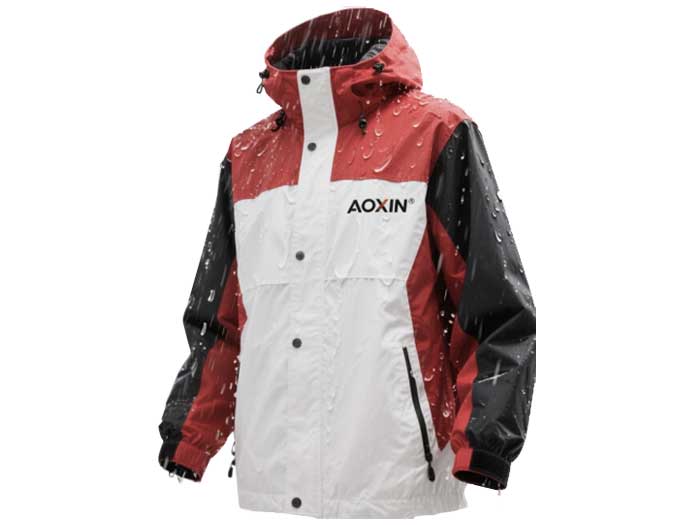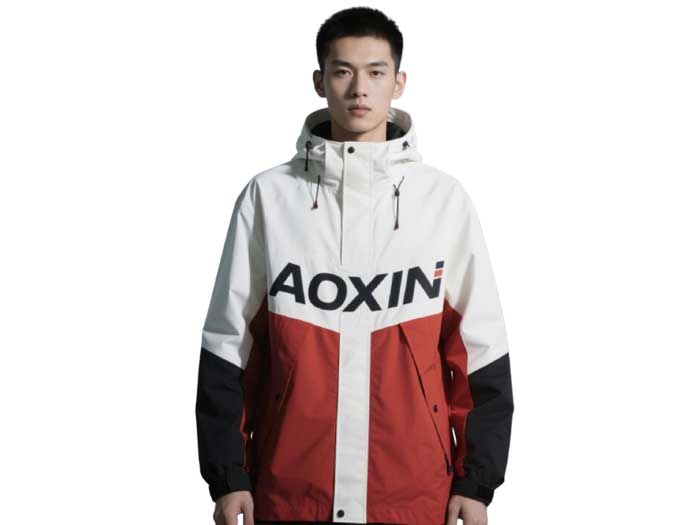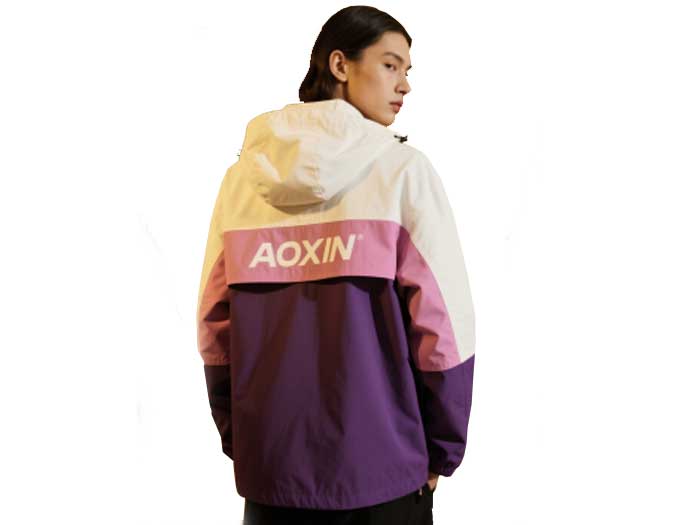1.Part 1: Materials and Technology – The Core of Hardshell Jacket Performance
The functionality of a hardshell jacket hinges on its materials and manufacturing technology. These elements directly determine its ability to resist water, retain warmth, and withstand wear, making them critical factors in your purchasing decision.
1. Waterproof and Breathable Membranes: The "Heart" of Weather Resistance
At the core of any high-performance hardshell jacket lies its waterproof and breathable membrane—a thin layer that blocks external moisture while allowing internal sweat vapor to escape. Three primary types dominate the market:
Gore-Tex: Renowned as the gold standard, Gore-Tex is a high-tech polytetrafluoroethylene (PTFE) membrane. Its structure features billions of micro-pores, each measuring 0.1–0.2 microns in diameter. This precision engineering is key: the pores are smaller than raindrops (which average 20–100 microns), preventing water from seeping in, yet larger than water vapor molecules (0.0004 microns), enabling efficient breathability. Ideal for extreme environments like alpine expeditions, Gore-Tex balances durability and performance, though it comes at a premium price.
PU Membrane (Polyurethane): A cost-effective alternative, PU membranes offer solid waterproofing and good durability. However, their breathability is slightly lower than Gore-Tex, as the material tends to trap more moisture during prolonged activity. They are well-suited for casual outdoor use or short trips in moderate rain.
TP Membrane (Thermoplastic Polyurethane): Lighter and more flexible than PU, TPU membranes boast a sleek, modern feel. While they provide decent breathability, their waterproof performance is generally weaker than both Gore-Tex and PU, making them better for light rain or urban commuting rather than heavy downpours.
2. Insulation Materials: Adapting to Cold Environments
For jackets used in low temperatures, insulation is vital to retain body heat. The choice between natural and synthetic insulation depends on your activity and environment:
Down: Derived from duck or goose feathers, down is prized for its exceptional warmth-to-weight ratio. Its clusters trap air efficiently, creating a thermal barrier that excels in dry, cold conditions. However, down loses nearly all its insulating properties when wet—once soaked, it clumps together and fails to retain air. It also requires careful maintenance (avoiding moisture) and is often more expensive.
Synthetic Insulation: Made from polyester fibers, synthetic insulation is designed to mimic down’s structure but with enhanced water resistance. Even when damp, it retains 70–80% of its warmth, making it ideal for wet climates or activities where sweating is likely (e.g., hiking in rain). It’s also machine-washable and dries quickly, requiring less upkeep than down. While slightly bulkier than down for the same warmth, synthetic options are more affordable and versatile.
3. Outer Fabrics and DWR Coating: Durability and Water Repellency
The outer fabric of a hardshell jacket must withstand abrasion from rocks, branches, and gear, while also working with the membrane to repel water. Most jackets use tough, lightweight fabrics like nylon or polyester, often reinforced with ripstop weaving (a grid pattern that prevents tears from spreading).
A critical finishing touch is the DWR (Durable Water Repellent) coating. Applied to the outer fabric, DWR causes water to bead up and roll off the surface, rather than soaking into the material. This not only enhances waterproofing but also reduces weight gain from absorbed moisture and helps maintain breathability—if water saturates the fabric, it can block the membrane’s pores, hindering vapor escape. Over time, DWR wears off due to washing and friction, but it can be restored with specialized sprays.

2.Part 2: Functional Details – Enhancing Outdoor Practicality
Beyond core materials, a hardshell jacket’s functional details turn it from a basic layer into a tool that adapts to your needs in the field. These features address real-world challenges like overheating, gear storage, and weather infiltration, ensuring comfort and convenience during activity.
1. Vents: Regulating Temperature During Activity
When hiking, climbing, or trekking, your body generates heat and sweat—without proper ventilation, moisture can get trapped inside, leading to discomfort or even chills as you cool down. Well-designed vents solve this problem:
Underarm Vents: The most common design, these are zippered openings under the arms that, when unzipped, create airflow across the torso. They are especially effective during high-intensity activity, as they release hot air directly from the body’s core.
Back or Chest Vents: Some jackets add vents on the back (near the shoulder blades) or chest to target areas prone to sweating. These are useful for activities like backpacking, where a pack might cover underarm vents.
Adjustable Vents: Look for vents with large, easy-to-grab zippers (even with gloves) and storm flaps to prevent rain from entering when open.
2. Pockets: Secure Storage for Essentials
Outdoor adventures require quick access to tools, snacks, or electronics—pockets must be practical, secure, and weather-resistant:
Waterproof Pockets: Critical for storing phones, cameras, or maps. These often feature welded seams or waterproof zippers to keep contents dry, even in heavy rain.
Chest Pockets: Positioned high on the chest, these are easily accessible while wearing a backpack (unlike hip pockets, which may be covered by a pack’s waist belt). They’re ideal for items you need frequently, like a compass or energy bars.
Inner Pockets: Useful for valuables or heat-sensitive items (e.g., batteries). Some include fleece lining to warm hands or protect delicate gear.
Security Features: Look for pockets with zipper garages (to prevent snags) or Velcro closures for added security, especially in windy conditions.
3. Wind/Snow Skirts and Adjustable Components: Sealing Out the Elements
Preventing cold air, rain, or snow from sneaking into the jacket is key to staying warm and dry. These features create a snug, weather-tight fit:
Wind Skirts: A elasticized or adjustable flap at the jacket’s hem, worn inside your pants or belt. It blocks wind from blowing up through the waist, a common source of heat loss.
Snow Skirts: Found on winter-specific jackets, these are wider, detachable flaps that attach to pants with snaps or hooks, creating a barrier against snow during activities like skiing or snowshoeing.
Adjustable Cuffs: Velcro straps, elastic, or drawcords at the wrists seal around gloves, preventing cold air or rain from entering. Some include thumb loops to keep cuffs in place under gloves.
Hood Adjustments: A good hood should fit over a helmet (for climbers) or hat, with toggles to tighten around the face and brims to shield eyes from rain or snow. Look for “3-way adjustment” (crown, sides, and back) for a customized fit.

Part 3: Care and Maintenance – Extending Your Jacket’s Lifespan
A high-quality hardshell jacket is an investment—proper care ensures it retains its waterproofing, breathability, and durability for years. Neglecting maintenance can reduce performance, forcing you to replace it prematurely.
1. Washing: Protecting Membranes and Coatings
Over time, dirt, sweat, and oils can clog the membrane’s pores or break down the DWR coating. Follow these steps to clean your jacket without damage:
Read the Label: Always check the care instructions—some jackets require gentle cycles, while others prohibit fabric softeners or bleach.
Use Specialized Detergents: Avoid regular laundry detergents, which leave residues that block breathability. Instead, use cleaners designed for waterproof gear (e.g., Nikwax Tech Wash or Granger’s Performance Wash). These remove dirt without harming membranes or DWR.
Wash in Cold Water: Hot water can damage adhesives or shrink fabrics. Use a front-loading washing machine (top-loaders with agitators may snag fabric) on a gentle cycle.
Skip Fabric Softeners or Bleach: These chemicals degrade DWR and membrane performance.
2. Drying: Preserving Fabric and Performance
Improper drying can warp seams, weaken fabrics, or ruin insulation. Follow these guidelines:
Air-Dry First: Hang the jacket in a well-ventilated area (away from direct heat sources like radiators) to let most moisture evaporate. This prevents overheating during machine drying.
Tumble Dry with Care (If Allowed): Some jackets can be tumble-dried on low heat to reactivate the DWR coating—the heat helps the coating redistribute evenly across the fabric. Add a few clean tennis balls to fluff insulation (for down or synthetic liners).
Avoid Sunlight: UV rays break down fabrics and DWR over time. Never dry your jacket in direct sunlight for extended periods.
3. Restoring DWR and Membrane Performance
Even with careful washing, DWR coating will wear thin over time (you’ll notice water soaking into the fabric instead of beading). Restore it before performance declines:
Reapply DWR Spray: Products like Nikwax TX.Direct or Granger’s Xtreme Repel can be sprayed on clean, dry fabric. Follow instructions to ensure even coverage, then air-dry or tumble-dry on low to set the coating.
Revive Membrane Breathability: If your jacket feels “clammy” despite being clean, the membrane may be clogged. A second wash with specialized detergent often resolves this.
Repair Small Damage: Fix rips or torn seams promptly with waterproof tape (e.g., Gear Aid Tenacious Tape) to prevent water from seeping in and damaging the membrane. For larger issues, many brands offer repair services.
By prioritizing these care steps, you’ll keep your hardshell jacket performing like new, ensuring it remains a reliable companion on countless adventures.



